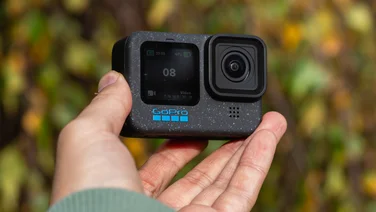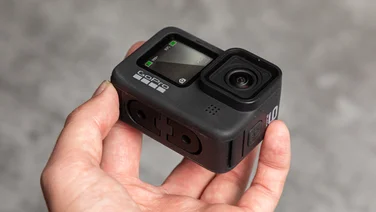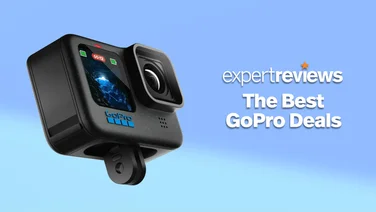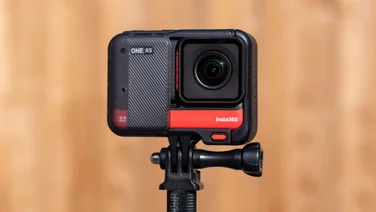To help us provide you with free impartial advice, we may earn a commission if you buy through links on our site. Learn more

- Onboard camera
- High quality 4K video
- Professional-looking results
- Easy set-up
- Restricted camera swivel
- No option to install third-party camera
- Difficult to find safe place to fly
Although the DJI Phantom drone came out back in 2015, it is still a great product and at the more affordable price of £799 from Maplin it is much better value than other products on the market.
Read Jon’s full review here:
Like a large, plastic and very angry wasp, the DJI Phantom 3 Professional hovers, stock still before me, flashing its directional LEDs in a menacing fashion. So far, all I’ve done is turn it on and hit the take-off button. Everything else, the drone takes care of itself.
With the assistance of GPS, digital compass, altimeter and gyroscopic sensors, it holds its position completely steady, with no user input – even moderately strong winds cause it only a momentary wobble. And all the while it’s recording high-quality 4K video footage via its motorised, stabilised onboard camera, and piping a live 720p video stream direct to the screen of my smartphone.
And how much does this miraculous box of tricks cost? An unmanned aircraft that effectively flies itself and can record near-broadcast-quality images? You might expect it to set you back thousands, even tens of thousands of pounds. But no: the DJI Phantom 3 Professional costs a mere £1,159 inc VAT, and the Phantom 3 Advanced (its 1080p counterpart) is even cheaper, at a ridiculously reasonable £899.
Our thanks to the lovely folk at FirstPersonView.co.uk for supplying the review sample.

What’s new?
It’s astonishing the amount of technology DJI has packed into its latest consumer quadcopter. Yet, outwardly, it looks much the same as the previous version – the Phantom Vision 2+, which I reviewed earlier this year. The only notable sign that anything is different is the new gold badge, and gold stripes adorning the arms of the drone. So what precisely is new? The answer is, despite appearances, a hell of a lot.
For starters, the new camera may look the same, but it’s capable of recording 4K video at up to 30fps and 1080p video at up to 60fps. It can snap stills 12 megapixels in size, shoot in bursts of up to seven frames, and capture automatically bracketed shots and time-lapse sequences.
And its Sony sensor produces stunning results, far superior to those I recorded with the Vision 2+. With a maximum video bit rate of 60Mbits/sec, it was possible to pick out tiny details hundreds of metres away; I could see individual blades of grass and leaves in the trees blowing in the breeze. Dynamic range was equally impressive, and the camera coped remarkably well with areas of extreme brightness and shadow. The lens isn’t quite as wide-angle as before, so there’s much less of a fisheye effect applied to your footage.

As with the Vision 2+, the camera is mounted on an active, motorised gimbal. This keeps the camera unit steady as a rock, even in moderate winds or close to the ground, and the overall result is seriously professional-looking results. With a little practice – although you still have to be gentle with the controls or footage looks jerky – it’s possible to produce the sort of super-smooth footage that wouldn’t look out of place in coverage of the Tour de France.
A couple of caveats remain. You can’t swivel the camera left or right by more than a degree or two, because the legs of the drone get in the way. And there’s no option to tie third-party cameras into the Phantom 3’s new Lightbridge connection system (more on which below), so you’re stuck with the supplied unit, come what may. But it’s so good that this shouldn’t concern most users.
You can get an idea of the quality in the video below (don’t forget to select the 4K option in the settings).
In control
If the camera is a major step forward, the new controller and app represent a quantum leap. Both have been borrowed from DJI’s more upmarket – and considerably more expensive – Inspire 1 drone, and they make the job of getting in the air, flying and recording much simpler than before.
For starters, setup is now much easier. Download the new DJI Pilot app (which also hosts a number of tutorials), and all you need to do to get connected is plug it in to your mobile device via the supplied cable.
It’s a bit fussy about the order you do everything, but really, there’s nothing more to it than that. There’s no fiddly connection via Wi-Fi any more – just plug in, calibrate the compass on the drone and you’re ready to fly.

And once you’re all hooked up, there’s plenty more to like. For novice flyers, there’s a beginner mode that restricts range and altitude until you’re comfortable with the flight controls. The new Lightbridge connection – which tethers the controller to the Phantom – now delivers live, 720p footage direct to the screen of your mobile device, making it far easier to make out what you’re filming onscreen.
In fact, with a strong-enough mobile data connection it’s even possible to live broadcast to YouTube, opening up all sorts of possibilities for TV companies – even independent journalists – covering live, breaking events.
There’s also an improved controller, with a much beefier bracket capable of larger tablets up to the 9.7in iPad, as well as smaller devices such as smartphones. All together, you have an amazingly capable and flexible flight system that’s a good deal more sophisticated than its predecessor.
And this is merely scratching the surface of what the Phantom 3 Professional is truly capable of. It has much, much more in its locker, from being able to customise the flight controls and adjust the sensitivity of the camera tilt wheel, to setting up geofences to control the flight range and manual camera controls.

For those concerned about the legal ramifications of flying in the wrong place by accident, the Phantom 3 comes limited to a flight ceiling of 400ft; and it won’t take off at all if you attempt to fly it in the vicinity of a sensitive area such as an airport, airfield or nuclear power station.
The new model even makes it easier to fly the drone inside: a pair of positional sensors on the belly of the Phantom 3 means it can hold steady without requiring a GPS signal – although you’ll still need a pretty large room in which to fly if you don’t want to run the risk of crashing. Residents of narrow Victorian terraces need not apply.
Verdict
The DJI Phantom 3 is so competent, so easy to fly and shoot video with, that the main worry I had while testing it was finding a safe place to fly. Even living even on the outskirts of London in a reasonably leafy suburb, I was able to locate few places nearby that were clear enough of people and far enough away from buildings and roads to satisfy the rules governing the piloting of such unmanned aerial vehicles (UAVs).
That’s something you should certainly bear in mind before making the kind of investment involved in buying a DJI Phantom 3 Professional. You should also make a point of reading the CAA’s advice guide on flying safely, which it issued recently in the wake of yet another near miss with a commercial airliner. I’d also recommend visiting FirstPersonView.co.uk’s Pilot’s Guide pages for a more detailed introduction and overview on the subject.
But if you have somewhere to fly it and can’t wait to get aboard the drone bandwagon, the DJI Phantom 3 Professional is a very good place to start.
Read our full roundup of the best drones for 2017







